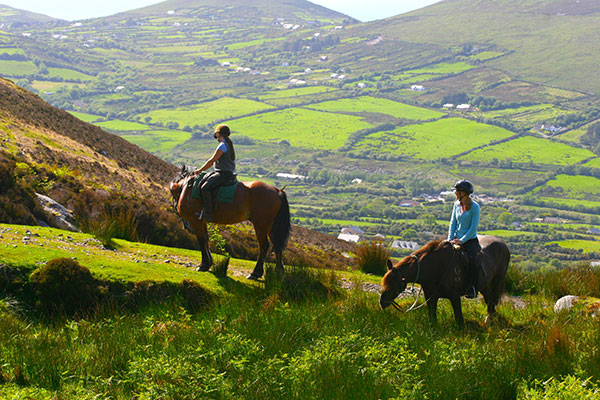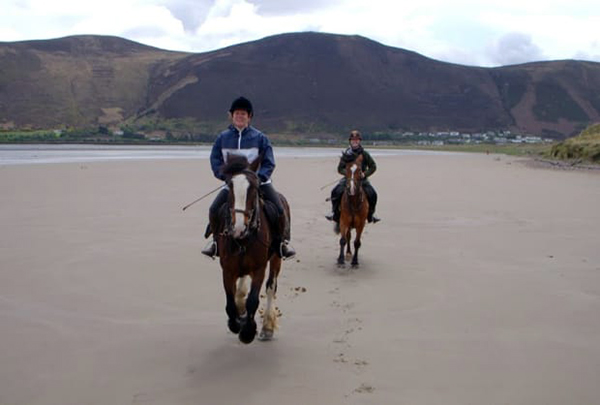There’s a reason that County Kerry, on the coast of southwest Ireland, is one of the country’s most popular travel destinations: it is absolutely beautiful. The Kerry Way Trail, a trail that winds along the scenic Ring of Kerry driving route on the Iveragh Peninsula, leads riders and walkers past lakes, some of Ireland’s highest mountains, the bright-blue waters of Dingle Bay, and everything in between. Sheep may walk alongside, their backs marked with colorful painted stripes to allow their owners to find them as they roam the yellow gorse and heather-covered hills.
The Ring of Kerry on Horseback
While most people experience the Ring of Kerry by vehicle, the best way to take in the beauty of this area is astride a horse. Instead of looking up at the scenery from a crowded roadside, riders are immersed in it, traveling by idyllic lakes and mountains and venturing high into the mountains to enjoy stunning vistas of the southwestern region as their horses carefully tread the increasingly rocky terrain.
Lough Caragh, a glassy five-mile-long lake surrounded by rolling green mountains, provides a good place to rest or enjoy an on-the-trail snack or picnic. Everywhere one looks, the views are spectacular. Valleys tumble into rivers and lakes below. A few small cottages lie at the base of the valley dissected by Lough Caragh, almost hidden by the trees.
County Kerry was particularly affected by the Potato Famine, during which many people either starved or emigrated from Ireland. Coffin ships, so called because of the deplorable conditions on board, left from two main ports in the southwest, their passengers hoping to find something better in the New World.
Stay clear of the lonely hawthorn trees that stand beside old cottages. They are said to be a sacred meeting place for fairies. According to an old superstition, cutting down this white flowering tree will bring bad luck to you and your family.

Mind The Windy Gap!
Continuing up the trails, riders come to the aptly named Windy Gap beside the summit of Seefin Mountain —no matter the time of year, conditions here are windy. The stony grass trail up to the gap is an old “mass road,” which once led to the only Catholic church in the area. Parishioners would walk barefoot, a sign of the hard times, from the village of Glen Car, approximately ten miles away, to attend mass on the opposite side of the Windy Gap. The trek up the road is steep and rocky, so horses must be quite fit to undertake this route.
At the top, small stone fences bisect one’s views of verdant green fields and valleys. Dingle Bay’s brilliant waters and sandy golden beaches shimmer in the distance, backed by the glacier cut Slieve Mish Mountains across the bay. This is quintessential Ireland.
Rossbeigh Beach Gallops
I cantered and galloped along some of the widest beaches I’ve ever seen along the Ring of Kerry’s Rossbeigh Beach in Ireland. In this designated natural heritage area, mountains meet the shore of the powerful Atlantic Ocean. My mount for the trip, Aladdin, who local guide Aoife O’Sullivan rode in Equitrekking’s Irish Countryside episode, listened well, picking up the pace with a slight squeeze and slowing down with a gentle whoa.

A strong, Irish Cob cross, Aladdin gave me confidence on the sand and at higher altitudes. We’d already ridden through Kerry’s lakes and mountains, where splendid panoramas of bright blue Dingle Bay pop against the lush green patchwork countryside. Down on the shore, Aladdin and I cantered sandwiched between high sand dunes and dramatic waters with mountains on the horizon.
We passed over an area of small, smooth emerald green, purple and deep grey rocks. I wanted to take some home and fill the bottom of a vase, but thought better of it. Neither Aladdin nor I wanted to canter holding a bunch of rocks. We rode to a tiny bay with a big story. It was here that mythical characters Oisín and Niamh are thought to have ridden a white horse across to The Land of Eternal Youth or Tír na nÓg. There are lots and myths and legends in this part of Ireland, an added plus for history buffs and Irish dreamers.



